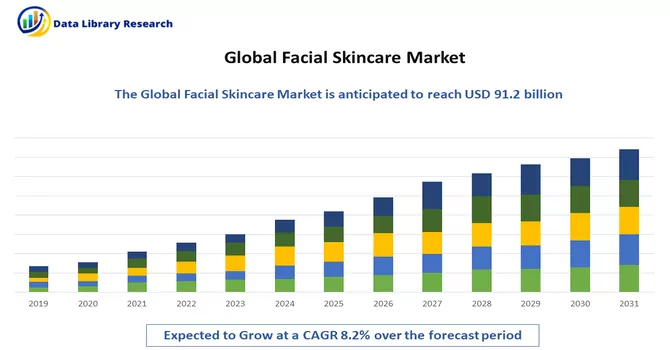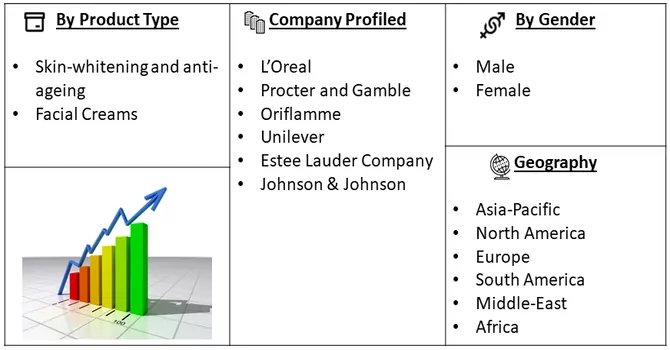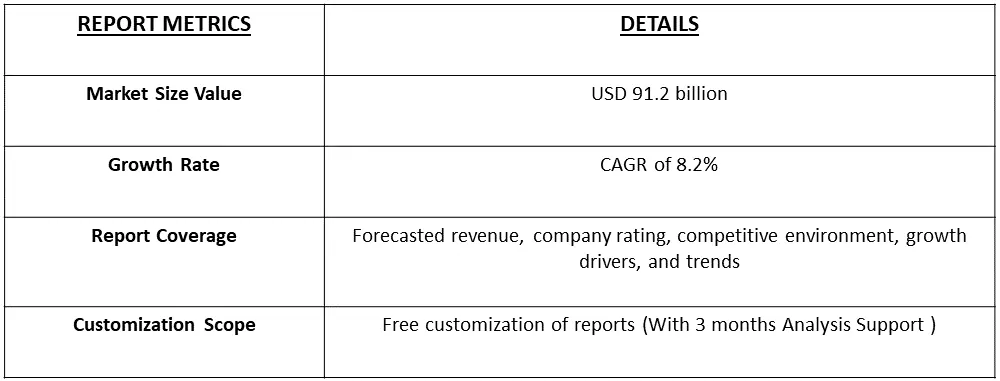The global facial skincare market was valued at USD 91.2 billion in 2023 and is expected to grow at a CAGR of 8.2% from 2024 to 2031.

Get Complete Analysis Of The Report - Download Free Sample PDF
Facial skincare refers to the practice of caring for the skin on the face through various routines, products, and treatments aimed at maintaining its health, appearance, and overall well-being. It encompasses a range of activities, including cleansing, moisturizing, exfoliating, and applying specific skincare products such as serums, toners, and sunscreen. The goal of facial skincare is often to address specific skin concerns, prevent signs of ageing, and promote a clear, radiant complexion. Individuals may adopt different skincare regimens based on their skin type, concerns, and desired outcomes. Regular facial skincare is considered essential for promoting healthy skin, preventing common issues like acne or dryness, and preserving a youthful and vibrant appearance.
Facial skincare products constitute a diverse array of formulations tailored to cleanse, nourish, treat, and safeguard the delicate skin on the face. With an increasing focus on self-care and wellness, skincare has evolved into a ritual that goes beyond addressing specific concerns to encompass a holistic approach to enhancing overall well-being. The ageing global population has driven a surge in the demand for anti-ageing and age-defying skincare solutions, responding to needs such as reducing wrinkles, and fine lines, and addressing concerns related to sagging skin. This trend underscores the evolving landscape of facial skincare, where products are not just functional but also play a role in promoting a sense of self-care and personal wellness.
The facial skincare market is witnessing several notable trends shaping the industry. Firstly, there is a growing inclination towards clean and sustainable beauty, with consumers increasingly seeking products with natural and eco-friendly ingredients. Brands are responding to this demand by incorporating clean formulations and sustainable packaging. Additionally, there is a rising focus on personalized skincare, driven by advancements in technology. Companies are leveraging data and AI to offer personalized skincare routines tailored to individual needs. Anti-pollution skincare is gaining prominence as consumers become more aware of environmental stressors on the skin. Furthermore, the convergence of skincare and wellness is evident, with products designed not only for cosmetic benefits but also for overall skin health and holistic well-being. Lastly, inclusive beauty is becoming a key trend, with brands expanding shade ranges and addressing diverse skincare needs across various skin types and tones.
Market Segmentation: The Facial Skincare Market is Segmented By Product Type (Skin-whitening and anti-ageing, and Facial Creams), Gender (Male and Female) and geography (North America, Europe, Asia-Pacific, South America, and Africa). The report offers the market size and forecasts in terms of volume in metric tons and value in USD thousand for all the above segments.

For Detailed Market Segmentation - Download Free Sample PDF
Market Drivers:
Growing Awareness Regarding the Skincare Products
The skincare industry is experiencing a surge in awareness among consumers, particularly regarding the importance of skin care products in maintaining skin health and addressing specific concerns. There is a growing consciousness about the impact of environmental factors, lifestyle choices, and ageing on skin quality. Consumers are increasingly informed about the benefits of using skincare products to cleanse, moisturize, and treat various skin issues. This heightened awareness is driving the demand for skincare products tailored to individual needs, such as anti-ageing creams, moisturizers, and specialized treatments. Brands are responding to this trend by promoting education on skincare routines, ingredients, and their benefits, fostering a more informed and discerning consumer base. For instance, a study published in India reported that 67.8% of people are likely to be more aware of their skin in the current decade compared to the 1990s.
Technological Development
Advancements in facial skincare technology continue to revolutionize the industry, offering innovative solutions for improved skincare routines and enhanced results. One notable development is the integration of Artificial Intelligence (AI) in age estimation and verification tools. Persona and Paravision have collaborated to introduce an AI-powered facial biometrics product designed with ethical considerations. This tool, trained on a diverse dataset and audited to detect and mitigate bias, represents an industry-first for age estimation.
Moreover, the utilization of LED Light Therapy in facial services is another technological trend. Spa franchises, such as those in North America, are partnering with companies like LightStim to incorporate FDA-cleared LED technology into skincare treatments. These treatments target concerns like wrinkles and acne, showcasing how technology is becoming an integral part of modern facial skincare services.
An example of cutting-edge skincare innovation is evident in L'Oréal Paris' Age Perfect Cell Renewal Midnight Serum, which has garnered significant market attention. This product incorporates hyaluronic acid for moisturization and the brand's Antioxidant Recovery Complex, a blend of vitamin E and bitter orange that reinforces the skin's defences, promoting a more radiant and smooth complexion. Additionally, in a groundbreaking move, L'Oréal announced on June 24, 2021, that it had utilized Carbios' enzymatic technology to create the first-ever cosmetic bottle entirely composed of recycled plastic. The company aims to commence the production of bottles using this pioneering technology by 2025. This highlights how skincare brands are actively embracing sustainable and eco-friendly solutions in product packaging, aligning with the growing consumer preference for environmentally conscious choices in the skincare industry.
Restraints:
High Cost of Facials
The growth of the facial skincare market faces potential challenges due to the high cost associated with facial treatments. While facial services often provide advanced and specialized skincare solutions, the expenses incurred may act as a deterrent for some consumers. The cost of professional facials, especially those incorporating advanced technologies and premium skin care products, can be relatively high. This may limit the accessibility of these services to a broader consumer base, impacting market growth. Affordability remains a crucial factor for consumers when considering skincare routines and treatments. The industry may need to address pricing concerns and explore strategies to make facial services more accessible to a diverse range of consumers. Implementing tiered pricing models, offering package deals, or introducing more budget-friendly options could be potential approaches to overcome the challenge posed by the high cost of facials and ensure sustained growth in the facial skincare market.
The COVID-19 pandemic has significantly impacted the facial skincare market. Lockdowns, social distancing measures, and economic uncertainties during the pandemic have led to shifts in consumer behaviour and preferences. With the closure of physical retail stores and reduced in-person interactions, there has been a surge in online sales of skincare products. The increased emphasis on personal health and wellness, coupled with more time spent at home, has prompted individuals to focus on self-care routines, contributing to the demand for facial skincare products. On the other hand, the economic challenges posed by the pandemic have influenced purchasing decisions, leading some consumers to prioritize essential items over non-essential products like luxury skincare. Additionally, disruptions in the supply chain and manufacturing processes have impacted product availability and distribution. As the world navigates through the pandemic and adapts to the new normal, the facial skincare market is expected to witness shifts in consumer preferences, with an ongoing focus on health, natural ingredients, and personalized skincare routines. The market is likely to rebound as economies recover, and consumer confidence returns, albeit with continued e-commerce dominance and an increased awareness of skincare's role in overall well-being.
Segmental Analysis:
Skin-whitening & Anti-ageing Segment is Expected to Witness Significant Growth Over the Forecast Period
Skin-whitening and anti-ageing facials have gained popularity as specialized skincare treatments designed to address specific concerns related to skin tone, pigmentation, and ageing. Skin-whitening facials often incorporate ingredients or procedures aimed at reducing hyperpigmentation, and dark spots, and promoting a brighter complexion. Ingredients such as vitamin C, kojic acid, and liquorice extract are commonly used to achieve skin-whitening effects. On the other hand, anti-ageing facials focus on addressing signs of ageing, including wrinkles, fine lines, and loss of skin elasticity. These facials may include treatments with ingredients like retinol, peptides, and hyaluronic acid to stimulate collagen production, improve skin texture, and provide a more youthful appearance. Combining both skin-whitening and anti-ageing benefits in a facial treatment caters to individuals seeking comprehensive skincare solutions. However, it's important to note that the efficacy of these facials can vary based on individual skin types and conditions. Consumers often seek professional advice and customized facials to address their specific needs, contributing to the growth of the skincare industry.
The female Segment is Expected to Witness Significant Growth Over the Forecast Period
Facials tailored specifically for female skincare needs have become a popular and integral part of the beauty and skincare industry. These facials are designed to address various concerns that are commonly associated with female skin, taking into consideration factors such as hormonal changes, sensitivity, and specific skin conditions. Female-oriented facials often focus on hydration, anti-ageing, and overall skin rejuvenation. They may incorporate ingredients like hyaluronic acid, collagen, and vitamins to boost skin health and vitality. Specialized treatments may also target issues such as hormonal acne, pigmentation due to pregnancy (melasma), and other skin challenges that women may face. Furthermore, these facials may provide a relaxing and pampering experience, recognizing the holistic connection between skincare and well-being. Some salons and skincare professionals offer customized facials tailored to individual skin types and concerns, allowing women to address their unique skincare needs. The evolving beauty industry continually introduces new formulations, techniques, and technologies to enhance the effectiveness of female-oriented facials, contributing to the growth of the skincare market and meeting the diverse needs of women seeking personalized and results-driven skincare solutions.
North America Region is Expected to Witness Significant Growth Over the Forecast Period
In North America, facials have become a significant aspect of the skincare and beauty industry, reflecting a growing emphasis on personal wellness and self-care. The region witnesses a robust market for facials, with a diverse range of skincare treatments catering to various skin concerns and preferences. Beauty salons, spas, and skincare clinics across North America offer a plethora of facial services, attracting consumers seeking professional skincare solutions. The market in North America is characterized by a high level of innovation, with skincare professionals and brands introducing new formulations, advanced technologies, and customized approaches to address the diverse needs of consumers. Facials in North America often incorporate cutting-edge ingredients, such as peptides, antioxidants, and botanical extracts, reflecting the region's focus on skincare innovation.
In September 2023, OLIVIAUMMA LLC officially unveiled its latest venture, introducing the new Korean Skin Care brand OLIVIAUMMA, Glass Skin Tanghulu™. Drawing inspiration from the popular Korean delicacy Tanghulu, a sugar-coated fruit with a glass-like appearance, the brand aims to capture the essence of the coveted "glass skin" look. Hye Young Kim, the Founder and CEO of OLIVIAUMMA, anticipates that this launch will mark a significant milestone in bringing a fresh wave of Korean beauty to the United States. The innovative concept aligns the visual appeal of Tanghulu with the desired glass skin aesthetic, presenting a unique and exciting addition to the skincare landscape. Thus, such developments are expected to boost the studied market’s growth over the forecast period.

Get Complete Analysis Of The Report - Download Free Sample PDF
The facial skincare market is characterized by intense competition, with major manufacturers actively pursuing diverse strategies to strengthen their market positions. Key players are strategically engaging in initiatives like introducing new products, expanding their geographical presence, undertaking mergers and acquisitions, fostering collaborations, and forming strategic partnerships. These efforts are aimed at enhancing their product portfolios, reaching wider consumer bases, and capitalizing on emerging opportunities in the dynamic skincare industry. The competitive landscape is dynamic, marked by continuous innovation and efforts to meet the evolving demands and preferences of consumers. Some prominent players in the global facial skincare market:
Recent Developments:
1) In Nov 2023: Persona and Paravision have introduced a cutting-edge age estimation and verification tool, integrating AI to humanize digital identity and establish ethical benchmarks for developers. According to a company statement, this face biometrics product prioritizes ethics, being trained on a diverse dataset and subjected to audits to identify and address biases. It is hailed as an industry-first approach to age estimation, showcasing a commitment to responsible and unbiased technology development.
2) In April 2023: The spa franchise brand based in North America has unveiled its latest facial service, LED Light Therapy, now offered at specific Retreats across the nation. Collaborating with LightStim and utilizing their FDA Cleared technology, the new service encompasses two treatments specifically crafted to diminish wrinkles and address acne and its associated inflammation.
Q1. What was the Facial Skincare Market size in 2023?
As per Data Library Research the global facial skincare market was valued at USD 91.2 billion in 2023.
Q2. At what CAGR is the Facial Skincare market projected to grow within the forecast period?
Facial Skincare Market is expected to grow at a CAGR of 8.2% over the forecast period.
Q3. What are the factors driving the Facial Skincare market?
Key factors that are driving the growth include the Growing Awareness Regarding the Skincare Products and Technological Development.
Q4. Which region has the largest share of the Facial Skincare market? What are the largest region's market size and growth rate?
North America has the largest share of the market. For detailed insights on the largest region's market size and growth rate request a sample here.
Data Library Research are conducted by industry experts who offer insight on industry structure, market segmentations technology assessment and competitive landscape (CL), and penetration, as well as on emerging trends. Their analysis is based on primary interviews (~ 80%) and secondary research (~ 20%) as well as years of professional expertise in their respective industries. Adding to this, by analysing historical trends and current market positions, our analysts predict where the market will be headed for the next five years. Furthermore, the varying trends of segment & categories geographically presented are also studied and the estimated based on the primary & secondary research.
In this particular report from the supply side Data Library Research has conducted primary surveys (interviews) with the key level executives (VP, CEO’s, Marketing Director, Business Development Manager and SOFT) of the companies that active & prominent as well as the midsized organization
FIGURE 1: DLR RESEARH PROCESS

Extensive primary research was conducted to gain a deeper insight of the market and industry performance. The analysis is based on both primary and secondary research as well as years of professional expertise in the respective industries.
In addition to analysing current and historical trends, our analysts predict where the market is headed over the next five years.
It varies by segment for these categories geographically presented in the list of market tables. Speaking about this particular report we have conducted primary surveys (interviews) with the key level executives (VP, CEO’s, Marketing Director, Business Development Manager and many more) of the major players active in the market.
Secondary ResearchSecondary research was mainly used to collect and identify information useful for the extensive, technical, market-oriented, and Friend’s study of the Global Extra Neutral Alcohol. It was also used to obtain key information about major players, market classification and segmentation according to the industry trends, geographical markets, and developments related to the market and technology perspectives. For this study, analysts have gathered information from various credible sources, such as annual reports, sec filings, journals, white papers, SOFT presentations, and company web sites.
Market Size EstimationBoth, top-down and bottom-up approaches were used to estimate and validate the size of the Global market and to estimate the size of various other dependent submarkets in the overall Extra Neutral Alcohol. The key players in the market were identified through secondary research and their market contributions in the respective geographies were determined through primary and secondary research.
Forecast Model
